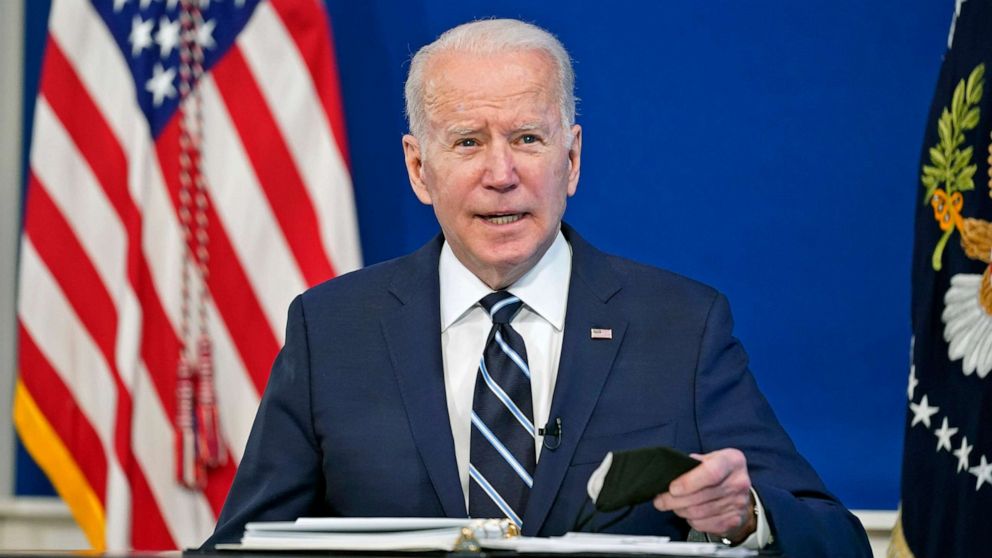What to know about Biden’s plan to ship Americans 1 billion free at-home COVID tests
Last month, President Joe Biden announced that 500 million free at-home rapid tests for COVID would be mailed out to American homes. On Thursday, Biden announced that he was doubling that promise and would now ship out another 500 million -- to make 1 billion in total.
Americans can begin ordering these tests on Wed., Jan. 19, through COVIDTests.gov, the White House announced on Friday. The first tests will ship out in late January or early February.
That's on top of 50 million free at-home tests already sent to community health centers around the country, 20,000 free testing sites and an insurance reimbursement plan that goes into effect on Saturday to allow Americans to get tests covered if they find and buy them at retailers.
Taken together, it all signifies a clear effort on behalf of the administration to increase the testing supply after the omicron variant surge caught the government off guard.
But a timeline for when the 1 billion free tests will reach American households remains elusive. From obtaining the kits to packaging and mailing them to some 160 million households, the plan could take weeks or months to complete – well beyond what experts project will be the peak of the Omicron surge.
When will you see your free tests from the government?
Biden first announced the plan to ship out free tests to all Americans around the holidays, when it was nearly impossible to find any on pharmacy shelves and lines for testing sites were hours long. The free tests were welcome news.
Though it's taken weeks for details to emerge, a website will launch on Wednesday for Americans to request up to four at-home rapid tests per household from the first batch of 500 million rapid tests, which the White House is in the process of securing.
Once Americans request the tests, which they can do by providing their name and address on COVIDTests.gov, the tests will ship out within 7-12 days.
Tens of millions of tests could go out in January, according to recently released contracts between the White House and testing companies, while more are expected to be delivered in February.
But interviews with the majority of the biggest at-home testing companies suggested that it will be weeks to months before all 1 billion tests could reach American doorsteps, meaning it's unlikely the average American will get free tests delivered in time for the January peak of omicron cases predicted by most models.
Senior administration officials have confirmed they'll be able to get the first tests out by early February, while an official with the Department of Health and Human Services gave a clearer timeline to Congress, telling senators that the full 500 million tests would go out over the course of the next 60 days.
Still, the free tests will allow Americans to have tests on-hand, in addition to other initiatives like free tests distributed at community health centers and in schools.
How hard will it be to deliver all of these tests?
It’s been increasingly difficult for testing companies to distribute their at-home rapid tests in the last few weeks.
"The supply chain challenges have been an issue for tests as they are with so many other goods and services," said Mara Aspinall, the head of the National Testing Action Program at the Rockefeller Foundation, which connects testing companies with state governments.
Some of it is general supply issues, like getting individual parts required to make the tests, but more and more Aspinall said she’s hearing that companies are seeing breakdowns in their shipping process because so many people are out with COVID.
And as more testing companies are authorized by the Food and Drug Administration, there’s more competition for the shipping companies that help get these tests out.
But for Biden’s plan, once the government gets the tests delivered to its warehouses, it'll use the U.S. Post Office to get tests out through first class mail -- hopefully bypassing distribution issues that testing companies face when they have to figure it out for themselves. Over the holidays, for example, USPS delivered over 13 billion pieces of mail and packages with an average delivery time of less than 3 days.
Mark Dimondstein, the president of the American Postal Workers Union, said Thursday that the Postal Service will retain up to 7,000 seasonal workers at 43 sites across the country to help package and label the tests, “and then from there, it will go into the regular mail stream,” a process that typically takes 2-5 days.
“This is absolutely feasible … as fast as the orders come in, the Postal Service should be able to handle it,” Dimondstein said. “Of course, the Biden administration needs to do its part for us to be able to do our part.”
As for the testing companies, Biden’s latest plan shows a commitment to avoiding the mistakes revealed by omicron.
Fast action requires manufacturing capabilities that the U.S. wasn't prepared for, in part because of the unpredictability of the virus but also due to the country's vaccine-focused approach over the past year, which drove down demand for tests and left the country with fewer tests when it needed them most.
"It is important for the U.S. to maintain the testing manufacturing capacity and supply during periods of low demand so we can respond to future variants and surges," John Koval, a spokesperson for the at-home testing company Abbott, told ABC News last week.
"We're on the right path now, but we can't be complacent or think that testing won't play a critical role in our ability to gather safely," he said.
ABC News' Mark Abdelmalek contributed to this report.




